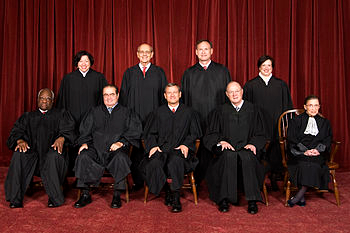U.S. Supreme Court under the Microscope:
Biodiversity statistics reveal mixed results in Court makeup
11 February 2013

Although the current Supreme Court has been criticized for its lack of diversity on the bench, the Court is actually more diverse overall today than ever in history, according to a new study that borrows statistical methods from ecology to reveal a more precise picture of diversity.
The study, which appears in the online edition of the Journal of Empirical Legal Studies, examines seven categories of diversity for every Supreme Court justice since the Court first convened in 1790 with Justice John Jay, including ethnic/racial origin, religion, professional background, childhood economic background, geographic background, education, and political affiliation. Gender was not included in the study because in part it would score almost constantly zero.
The current Supreme Court is slightly more diverse than it has been historically, the study found, particularly with high diversity in professional background, childhood economic background and racial origin.
Yet, the Court is not "optimally diverse," the study said, noting a recent downward trend in diversity of geographic background, with more justices from northeastern states, and religious affiliation, with Protestantism and other major religious groups showing less representation today. In addition, the Court completely lacks in educational diversity with every justice having attended either Harvard or Yale Law Schools.
"The lack of educational diversity is worrisome. Diversity is good in a small decision-making body. Studies have shown that it sparks creativity and improves decision-making," said Ben Barton, the study's co-author and professor of law at the University of Tennessee-Knoxville (UTK).
One of the goals of the study was to apply statistical techniques that have been used reliably by ecologists to study biodiversity but have never before been used in the study of law. The two statistical indices used – the Simpson's Diversity Index and Shannon's Diversity Index – are common and high-regarded measures used in ecology since the 1940s.
"These indices take into account both the number of categories represented – such as species or religions – and the evenness with which they are represented. Just as a forest that is 90 percent maple with three other species at low abundance is generally considered less diverse than one in which all four species are at similar abundance, a human group must move beyond 'token' representation before it can be considered truly diverse," said Emily Moran, currently a postdoctoral researcher at the Swiss Federal Institute of Technology in Zurich, Switzerland.
Moran worked with Barton on the study while she was a postdoctoral fellow at the National Institute for Mathematical and Biological Synthesis (NIMBioS), located at UTK. NIMBioS focuses on finding solutions to biological problems via mathematics.
"This is one of those unexpected outcomes from an interdisciplinary center like NIMBioS in which tools from one area of science can be applied beneficially in an area outside of science," said NIMBioS Director Louis Gross.
Citation: Barton BH, Moran E. 2013. Measuring diversity on the Supreme Court with biodiversity statistics. Journal of Empirical Legal Studies. Published online 18 January 2013.
Contact Information: Catherine Crawley, NIMBioS at ccrawley@nimbios.org; 865-974-9350
#
The National Institute for Mathematical and Biological Synthesis (NIMBioS) brings together researchers from around the world to collaborate across disciplinary boundaries to investigate solutions to basic and applied problems in the life sciences. NIMBioS is supported by the National Science Foundation, the U.S. Department of Homeland Security, and the U.S. Department of Agriculture with additional support from The University of Tennessee, Knoxville.
NIMBioS
1122 Volunteer Blvd., Suite 106
University of Tennessee
Knoxville,
TN 37996-3410
PH: (865) 974-9334
FAX: (865) 974-9461
Contact NIMBioS


